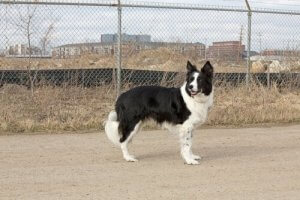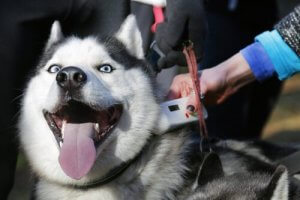Identify Lost Dogs with a Microchip for Dogs

Only those who’ve lost a dog know what it means to walk around looking desperately, going from door to door, placing posters (or sharing their photo on social media). A good solution would be using a microchip for dogs to find your furry friend.
Microchip for dogs in England and Uruguay
Since April 2016, British dogs have had to have a microchip. This way, owners will be more responsible and there will be fewer abandoned dogs on the streets. In Great Britain, there are around one hundred thousand lost or abandoned dogs every year. Costs for finding lost dogs and taking care of abandoned ones rise up to 60 million dollars.

In half the cases, it’s not possible to find the owners. So, dogs end up either in a kennel waiting for somebody to adopt them (although in some cases, dogs end up again on the streets or they’re run over by a car).
The solution to this problem is to implant a microchip the size of a grain of rice under a dog’s skin, usually between their shoulder blades. This technology allows all citizens, as well as the registry, to know who is the owner.
Although most British dogs already have a microchip, as of three years it was mandatory for all dogs. The owners need to contact the registry if they change their home address. Otherwise, there is a fee of 600 dollars.
The case of Uruguay is more recent. The South American country has launched a project for dogs to use the same system as cattle.
Besides making it easier to find a lost dog, microchips also help with regulating the dog population and organizing adoption programs. Each person or family can adopt any dog, but they must take responsibility for them. Otherwise, the authorities will fine them.
What is a microchip for dogs and why use it?
Aside from a government campaign, we can choose to implant an electronic chip in our dogs to protect them from getting lost or finding them in case they escape.
People also use animal identification devices for horses and cows, and it has two parts: a microchip and a capsule that covers it, all manufactured in a way that doesn’t cause allergies.
A veterinarian implants microchips with a special injector, usually between the dog’s shoulder blades. Each microchip has a unique registration number. Microchips for dogs are for a lifetime and it doesn’t interfere with their growth. You can microchip your dog once they’re 2 months old.
Owners must fill in the paperwork related to the microchip, such as home address and phone number. This information will be stored in the system and authorities will only use it to help to find lost dogs. Owners must report any changes, including removals or their dog’s death.
These are some excellent advantages of using a microchip:

- Shows ownership of the dog
- Easier to find lost dogs
- Less abandoned dogs
- We can find our pets if they escape
In the event of your dog getting lost or somebody stealing your dog, the system will notify the local police or the registration company.
Unlike the identification tag we can put on the collar, the microchip for dogs is safer because it can’t get lost, you can’t remove it, and the data is more reliable. We can use a microchip as well as an identification tag. You can use tags in case a neighbor finds your dog.
Only those who’ve lost a dog know what it means to walk around looking desperately, going from door to door, placing posters (or sharing their photo on social media). A good solution would be using a microchip for dogs to find your furry friend.
Microchip for dogs in England and Uruguay
Since April 2016, British dogs have had to have a microchip. This way, owners will be more responsible and there will be fewer abandoned dogs on the streets. In Great Britain, there are around one hundred thousand lost or abandoned dogs every year. Costs for finding lost dogs and taking care of abandoned ones rise up to 60 million dollars.

In half the cases, it’s not possible to find the owners. So, dogs end up either in a kennel waiting for somebody to adopt them (although in some cases, dogs end up again on the streets or they’re run over by a car).
The solution to this problem is to implant a microchip the size of a grain of rice under a dog’s skin, usually between their shoulder blades. This technology allows all citizens, as well as the registry, to know who is the owner.
Although most British dogs already have a microchip, as of three years it was mandatory for all dogs. The owners need to contact the registry if they change their home address. Otherwise, there is a fee of 600 dollars.
The case of Uruguay is more recent. The South American country has launched a project for dogs to use the same system as cattle.
Besides making it easier to find a lost dog, microchips also help with regulating the dog population and organizing adoption programs. Each person or family can adopt any dog, but they must take responsibility for them. Otherwise, the authorities will fine them.
What is a microchip for dogs and why use it?
Aside from a government campaign, we can choose to implant an electronic chip in our dogs to protect them from getting lost or finding them in case they escape.
People also use animal identification devices for horses and cows, and it has two parts: a microchip and a capsule that covers it, all manufactured in a way that doesn’t cause allergies.
A veterinarian implants microchips with a special injector, usually between the dog’s shoulder blades. Each microchip has a unique registration number. Microchips for dogs are for a lifetime and it doesn’t interfere with their growth. You can microchip your dog once they’re 2 months old.
Owners must fill in the paperwork related to the microchip, such as home address and phone number. This information will be stored in the system and authorities will only use it to help to find lost dogs. Owners must report any changes, including removals or their dog’s death.
These are some excellent advantages of using a microchip:

- Shows ownership of the dog
- Easier to find lost dogs
- Less abandoned dogs
- We can find our pets if they escape
In the event of your dog getting lost or somebody stealing your dog, the system will notify the local police or the registration company.
Unlike the identification tag we can put on the collar, the microchip for dogs is safer because it can’t get lost, you can’t remove it, and the data is more reliable. We can use a microchip as well as an identification tag. You can use tags in case a neighbor finds your dog.
This text is provided for informational purposes only and does not replace consultation with a professional. If in doubt, consult your specialist.








